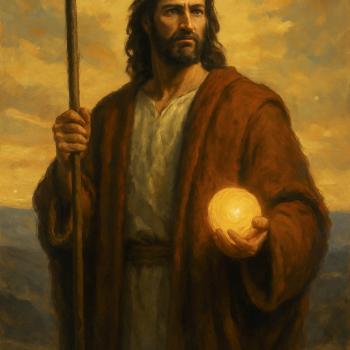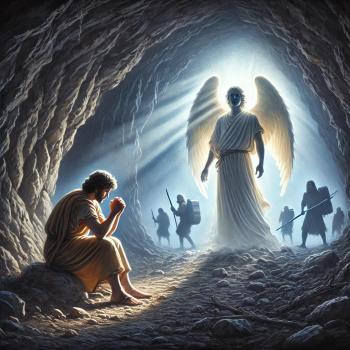How to Find Fulfillment in Jesus Christ
Mark 2:13-22
As we continue our series through the Gospel of Mark, we look today at the second of three themes in this chapter. First, we looked at forgiveness. Today we will look at the idea of fulfillment.
Here we have three different scenes of fulfillment.
THREE WAYS ONE FINDS FULFILLMENT IN JESUS
1. To Follow (Mark 2:13-14)
“Jesus went out again beside the sea. The whole crowd was coming to him, and he was teaching them. Then, passing by, he saw Levi the son of Alphaeus sitting at the toll booth, and he said to him, “Follow me,” and he got up and followed him.” (Mark 2:13–14, CSB)
The first fulfillment is found when we follow Jesus. Here, we see disciples come out of the crowd to follow Jesus. The same is true today. There are many people who comprise the community. From that community, which does not in general care about Jesus, there are those who show interest. These people are part of the crowd. From the crowd, one can see that there will be people who will decide to commit to Jesus and follow Him. The difference between the crowd and those who commit to Jesus is the fact that the followers of Jesus find fulfillment in Him.
2. To Serve (Mark 2:15-17)
“While he was reclining at the table in Levi’s house, many tax collectors and sinners were eating with Jesus and his disciples, for there were many who were following him. When the scribes who were Pharisees saw that he was eating with sinners and tax collectors, they asked his disciples, “Why does he eat with tax collectors and sinners?” When Jesus heard this, he told them, “It is not those who are well who need a doctor, but those who are sick. I didn’t come to call the righteous, but sinners.”” (Mark 2:15–17, CSB)
The second way one finds fulfillment is by serving. One goes from just following Jesus to actually serving Him. Jesus says that He came to heal, to help the sick. Jesus serves the sinners, not the righteous. In this way, He is giving us an example. We should be willing to serve Jesus by reaching out to those around us. Earlier, the crowd came to Jesus and people were drawn out of the crowd to follow Jesus. Here, Jesus goes to the crowd. He goes to the people who the Pharisees did not want to reach – the sinners and tax collectors. In this way, Jesus is giving us an example. We are called to serve those around us, especially the less fortunate than ourselves.
Here, there are three pictures of service:
THREE PICTURES OF SERVICE
1. The Physician (Mark 2:16-17)
“When the scribes who were Pharisees saw that he was eating with sinners and tax collectors, they asked his disciples, “Why does he eat with tax collectors and sinners?” When Jesus heard this, he told them, “It is not those who are well who need a doctor, but those who are sick. I didn’t come to call the righteous, but sinners.”” (Mark 2:16–17, CSB)
But there are three kinds of “patients” whom Jesus cannot heal of their sin sickness: (1) those who do not know about Him; (2) those who know about Him but refuse to trust Him; and (3) those who will not admit that they need Him. The scribes and Pharisees were in that third category, as are all self-righteous sinners today. Unless we admit that we are sinners, deserving of God’s judgment, we cannot be saved. Jesus saves only sinners.
“For the Son of Man has come to seek and to save the lost.”” (Luke 19:10, CSB)
2. The Bridegroom (Mark 2:18-20)
“Now John’s disciples and the Pharisees were fasting. People came and asked him, “Why do John’s disciples and the Pharisees’ disciples fast, but your disciples do not fast?” Jesus said to them, “The wedding guests cannot fast while the groom is with them, can they? As long as they have the groom with them, they cannot fast. But the time will come when the groom will be taken away from them, and then they will fast on that day.” (Mark 2:18–20, CSB)
Jesus had already made it clear that He came to convert the sinners, not to compliment the self-righteous. Now He told them that he had come to bring gladness, not sadness. Thanks to the legalism imposed by the scribes and Pharisees, the Jewish religion had become a burdensome thing. The poor people were weighed down by rules and regulations that were impossible to obey (Matt. 23:4). “Life is not supposed to be a funeral!” Jesus told them. “God wants life to be a wedding feast! I am the Bridegroom and these people are My wedding guests. Are not wedding guests supposed to have a good time?”
We will return to this theme in a minute. But before we get to it, we have to address the third picture of service. The picture of a tailor:
3. The Garment and Wineskins (Mark 2:21-22)
“No one sews a patch of unshrunk cloth on an old garment. Otherwise, the new patch pulls away from the old cloth, and a worse tear is made. And no one puts new wine into old wineskins. Otherwise, the wine will burst the skins, and the wine is lost as well as the skins. No, new wine is put into fresh wineskins.”” (Mark 2:21–22, CSB)
Jesus taught two important lessons about His ministry: (1) He came to save sinners, not to call the religious; and (2) He came to bring gladness and not sadness. The third lesson is this: He came to introduce the new, not to patch up the old.1
Combined, I think these small parables reflect not the just the truth that Jesus came to introduce a new idea, but also a new system. Jon Courson uses the following illustration to explain what Jesus means.
There are those who suggest that Jesus came to reform Judaism. Jesus, however, says “I’m not talking about patching up the old system or refilling old wineskins. Something new is happening.” The question then arises: What did He mean when He declared in Matthew 5 that He came not to destroy the old, but to fulfill it? Perhaps the answer is best illustrated with an acorn. If I set an acorn on the ground and hit it repeatedly with a hammer, it would soon be destroyed. If, on the other hand, I bury it in the ground, it would likewise be destroyed. But in the second case, its destruction would bring about fulfillment, for it would bring forth a whole new tree.
When Jesus said, “I have come to fulfill the Law,” it was in the sense of the buried acorn. That is, once the law shows us we’re sinners in need of a Savior, its work is complete—fulfilled in the Person of our Savior, Jesus Christ.2
The church would be made up of servants, not just people who would continue to the old traditions. Every work of God is a new work because it will be used to reach a new generation. As a matter of fact, Jesus strongly suggests that new ideas will come and that they should not be hindered by people in the church. So Jesus moves from calling His people out of the crowd to going back to the crowd. He moves back and forth. In each case, Jesus is giving us a way to see how one can get “a taste” of Him.
3. To Enjoy (Mark 2:18-22)
“Now John’s disciples and the Pharisees were fasting. People came and asked him, “Why do John’s disciples and the Pharisees’ disciples fast, but your disciples do not fast?” Jesus said to them, “The wedding guests cannot fast while the groom is with them, can they? As long as they have the groom with them, they cannot fast. But the time will come when the groom will be taken away from them, and then they will fast on that day. No one sews a patch of unshrunk cloth on an old garment. Otherwise, the new patch pulls away from the old cloth, and a worse tear is made. And no one puts new wine into old wineskins. Otherwise, the wine will burst the skins, and the wine is lost as well as the skins. No, new wine is put into fresh wineskins.”” (Mark 2:18–22, CSB)
People look at this passage and immediately think that this is the conflict about fasting. The Pharisees and John’s disciples fast. It was a normal practice. But the disciples of Jesus don’t fast. Why not? The reason Jesus gives is that He is there among them personally. Fasting is the practice of getting closer to God by denying yourself of physical pleasure in food. Jesus says that while He is here, the disciples don’t need to fast. They can spend time enjoying Him. He compares His presence to the groom at the wedding. While the groom is there, the people come to enjoy the groom at the wedding. But when the groom is gone, the people will fast. Jesus doesn’t deny that one should practice fasting.
But I think that He is eluding to the change in the practice of fasting. Fasting is not meant to be something that is a painful experience. Instead, fasting should be an enjoyable experience. I think this the reason that Jesus gives the short parables when He explains why His disciples don’t fast. First, they don’t fast because Jesus is in their midst like the groom at the wedding. Second, they don’t fast because Jesus is the new garment that they will wear. Third, they don’t fast because Jesus is the new wineskin.
Now when Jesus is gone, they will go back to fasting. But I think Jesus hints that the practice of fasting will serve a different purpose. I think this is the reason why the last two parables speak about something being new. I think its connection to the wedding means that the practice needs to be one of enjoyment, not pain. Because Jesus paid the sin debt, I don’t fast to fulfill a sin problem. I don’t do it for just a religious act of contrition alone. Instead, I do it to enjoy my relationship with Jesus. Fasting becomes not just about my denial of sin, but my enjoyment of Jesus. When seen in this way, one can understand that fasting is a fulfilling practice.
I think the Old Testament prophet was suggesting this when he asked the question:
““Ask all the people of the land and the priests: When you fasted and lamented in the fifth and in the seventh months for these seventy years, did you really fast for me? When you eat and drink, don’t you eat and drink simply for yourselves? Aren’t these the words that the Lord proclaimed through the earlier prophets when Jerusalem was inhabited and secure, along with its surrounding cities, and when the southern region and the Judean foothills were inhabited?”” (Zechariah 7:5–7, CSB)
The people had lost sight of the purpose of fasting. Yes, fasting was a form of physical denial so that one could focus on God and the spiritual. However, it turned into a spiritual practice that did not fulfill its purpose. The fasts, as well as the feasts, had become a secular practice. Just like today, our “holy days” have become “holidays” that only serve a secular agenda. When people think of the next three months, they will think of Halloween, Thanksgiving, Christmas, and New Years. When one thinks about these days, it is about celebrations, decorations, festivals, food, and enjoyment. However, there is no fulfillment in these practices because God is absent from the holidays.
For example, Halloween is literally Hallow’s Eve or Holy Evening because it is the night before All Saint’s Day. The point is that it was a holy celebration that has been mixed with pagan rituals. Instead of being something that points people to God, it just becomes another secular celebration with no holy intent. Thanksgiving, which is a uniquely American holiday, was originally combined with a Fasting Day. The original settlers fasted on one day to honor God and feasted on another day to thank God for the bountiful harvest. Today, there is no fasting at Thanksgiving. Instead, we have parades, football, turkey, and Black Friday (or more precisely Black Thursday/Friday) shopping events. This leads us to the season of Christmas. Christmas is less about the birth of Jesus Christ and more about “gift giving.” Starting with Black Friday, and Cyber Monday, we spend the rest of the month focusing on celebrations, parties, presents, and all the other stressful events that one must attend before Christmas. Then we rush to church on Christmas Eve, or we might attend a Christmas service to give God lip service. But we are not truly celebrating. The rush continues into the New Year. After the New Year begins, there doesn’t seem to be a sense of fulfillment. Instead, there is a sigh of relief that the rat race is over, at least once our property taxes are paid.
The same is true with fasting here. Jesus introduces the idea that fasting is for enjoyment. It should be a fulfillment of what Jesus has done. We say as Southern Baptists that we baptize to show others that we have been saved. We partake of the Lord’s Supper as a symbol of what Jesus has done for us. The baptism is performed once as an individual. The Lord’s Supper is continuously observed as a community. I think fasting, while not one of the two ordinances that Jesus gave, should be viewed the same way. I fast sometimes to get closer to God so that I can better understand His will. Yet, there are times when I can fast simply to spend time with God and enjoy Him. I can spend time worshiping Him and getting closer to Him. Fasting is staying physically hungry so that I may increase my hunger for God. My hunger for God comes from a desire to be with Him more, not because I feel guilty that I am not with Him more often.
John Piper explains the difference in fasting that Jesus showed from these verses. Perhaps his explanation will help you see fasting as a practice of fulfillment3:
What’s new about the fasting is that it rests on all this finished work of the Bridegroom. The yearning that we feel for revival or awakening or deliverance from corruption is not merely longing and aching. The first fruits of what we long for have already come. The down payment of what we yearn for is already paid. The fullness that we are longing for and fasting for has appeared in history and we have beheld his glory. It is not merely future.
We have tasted the powers of the age to come, and our new fasting is not because we are hungry for something we have not tasted, but because the new wine of Christ’s presence is so real and so satisfying. The newness of our fasting is this: its intensity comes not because we have never tasted the wine of Christ’s presence, but because we have tasted it so wonderfully by his Spirit and cannot now be satisfied until the consummation of joy arrives. We must have all he promised. And as much now as possible.
1 Warren W. Wiersbe, The Bible Exposition Commentary, vol. 1 (Wheaton, IL: Victor Books, 1996), 117.
2 Jon Courson, Jon Courson’s Application Commentary (Nashville, TN: Thomas Nelson, 2003), 232–233.
3 John Piper, Sermons from John Piper (1990–1999) (Minneapolis, MN: Desiring God, 2007).
Photo by Robert Nyman on Unsplash
Other Posts:
How to Build Better Personal Relationships With Others














